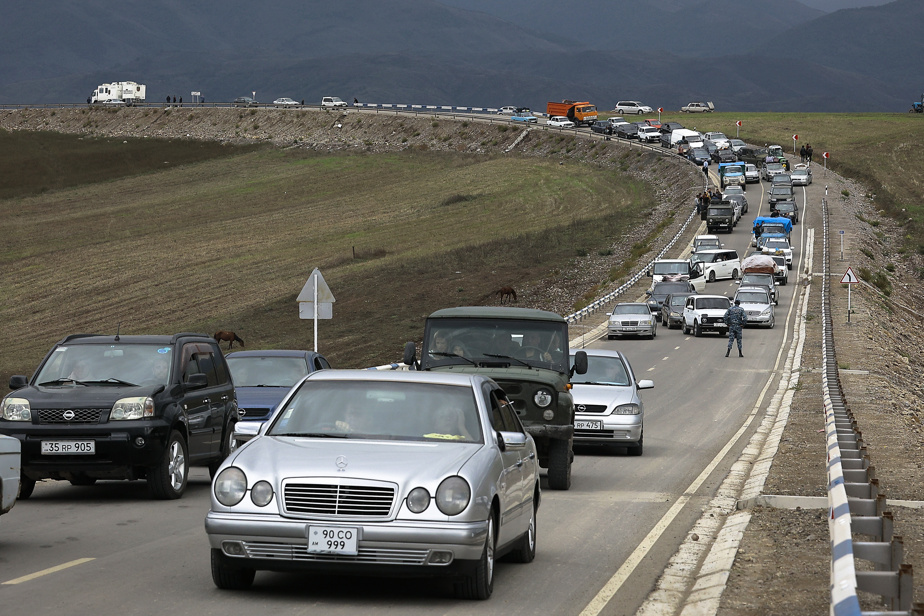(Lachin Corridor) Thousands of residents of Nagorno-Karabakh seek to flee their region on Tuesday to cross into Armenia where more than 28,000 of them have already found refuge, a week after an offensive by Azerbaijan in this region Caucasian secessionist.
According to Armenian authorities, some 28,120 refugees have arrived in Armenia from Nagorno-Karabakh so far.

Azerbaijan opened the only road leading from this region to Armenia on Sunday, four days after the capitulation of the separatists and a ceasefire agreement which places Nagorno-Karabakh under the control of Baku.
The head of American diplomacy Antony Blinken called on Azerbaijan to respect its commitments to protect civilians in the province and to allow access for humanitarian aid.
“The Secretary of State spoke again with President Aliyev today and emphasized the urgency of ending hostilities, ensuring the unconditional protection and freedom of movement of civilians, and ensuring access unimpeded humanitarian response in Nagorno-Karabakh,” State Department spokesperson Matthew Miller said.
France, for its part, called for “international diplomatic action” in the face of “Russia’s abandonment of Armenia”.
Paris estimated that the “massive” exodus of Armenians from Nagorno-Karabakh is taking place “under the complicit eye of Russia”, which had deployed a peacekeeping force in this secessionist region in 2020.
The European Union has demanded that Azerbaijan detail its “vision” regarding the future of Armenians living in Nagorno-Karabakh.
In a statement, the EU underlines the “need for transparency and access for international humanitarian aid and officials responsible for ensuring respect for human rights, and for more details on Baku’s vision regarding the “future of the Armenians of Nagorno-Karabakh in Azerbaijan”.
In the flow of Armenian refugees, Azerbaijan is looking for possible perpetrators of “war crimes”, an Azerbaijani government source told AFP on Tuesday.
“Azerbaijan intends to provide amnesty to Armenian fighters who laid down their arms in Karabakh. But those who committed war crimes during the Karabakh wars must be handed over to us,” the source said.
Monday evening, in the midst of an exodus, a fuel depot exploded in the enclave mainly populated by Armenians, killing at least 68 people, 290 injured and 105 people missing, the separatist authorities announced.

PHOTO VIA AGENCE FRANCE-PRESSE
A fuel depot exploded in the Nagorno-Karabakh enclave, killing at least 20 people and injuring 280.
An endless stream of vehicles carrying families and their belongings piled on the roofs rushed Tuesday to the last Azerbaijani checkpoint before Armenian territory, via the Lachin corridor.
“Expelled”
Some passed on foot. “They expelled us,” said one man as he passed the Azerbaijani soldiers.
On Monday, Azerbaijani President Ilham Aliyev reaffirmed the promise that the rights of Armenians in the enclave would be “guaranteed”.
The head of state spoke alongside his Turkish counterpart Recep Tayyip Erdogan, a key player in the region, just a few days after the victory of Azerbaijani soldiers against the troops of the self-proclaimed “republic” of Nagorno-Karabakh – attached to 1921 to Azerbaijan by Soviet power.
Armenia and Azerbaijan are two former Soviet republics which clashed militarily in Nagorno-Karabakh from 1988 to 1994 (30,000 deaths) and in the fall of 2020 (6,500 deaths). The death toll from last week’s lightning invasion is 200 dead, according to the Armenian side.
The European Union brought together senior French, German, Azerbaijani and Armenian diplomatic officials in Brussels on Tuesday.
According to the EU press release, the discussions allowed for “intense exchanges between participants on the relevance of a possible meeting of the leaders” of Armenia and Azerbaijan, on the sidelines of an informal European summit of 27 in Granada, southern Spain on October 5.
This summit was planned for a long time and was not canceled.
” Nowhere to go “
Azerbaijan has pledged to allow rebels who surrender their weapons to go to Armenia.
Many fear that Armenians will flee en masse from Nagorno-Karabakh as Azerbaijani forces tighten their grip.

PHOTO ALAIN JOCARD, AGENCE FRANCE-PRESSE
Because in addition to the anxiety that reigns among the approximately 120,000 inhabitants of the region, the humanitarian situation remains very tense.
The influx of refugees into Armenia has led to huge traffic jams on the only road linking the “capital” of the breakaway region, Stepanakert, to this country.
Since Sunday evening, it has overwhelmed the border town of Goris populated by around twenty thousand inhabitants, the first stop for most of the refugees.
Passing the Kornidzor post, immediately after the border, those who have “nowhere to go” are brought there, like Valentina Asrian, whose brother-in-law was killed in last week’s bombings and who is holding her grandson swaddled against her body.
“We have lived through terrible days,” said Anabel Ghulasyan, 41, from the village of Rev, known as Shalva in Azeri.
In front of the Goris theater, white minibuses arrive constantly. Others leave, their trunks loaded with luggage, towards Yerevan and the country’s major cities.
Last week, Armenian Prime Minister Nikol Pashinian announced that his country of 2.9 million inhabitants was preparing to welcome 40,000 refugees.
Russia, which sees the Caucasus as its backyard and deployed a peacekeeping force in this territory three years ago after a brief offensive by Azerbaijan, for its part firmly rejected on Monday the criticisms made by Ms. .Pachinian who accused her of having abandoned her ally.
